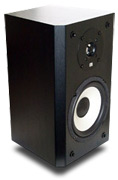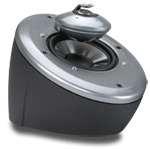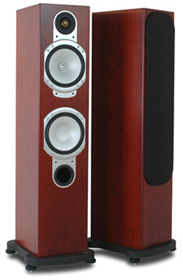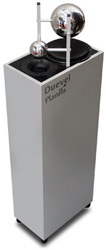Today’s Loudspeakers: Advanced
Technologies, High-Quality Parts, and Great Sound at Low Prices
About ten years ago, the bulk of low- and
medium-priced loudspeakers weren’t all that special -- not in terms of what they
looked like or how they were built. Most came in lousy-looking, vinyl-veneered boxes made
of MDF or even cheap chipboard, with driver and crossover parts that weren’t much to
write home about. The most successful such speakers were usually those whose designers had
worked hard to wring the best sound quality they could from such ordinary parts -- not
unlike a great chef who can make a fabulous meal out of everyday ingredients. But in the
last ten or so years, that trend of mundane lower-priced speakers has begun to change --
something I noted in my original review of Axiom
Audio’s M3Ti loudspeaker in December 2000.
 Unlike so many boxy, ordinary
two-ways available at the time, the Axiom M3Ti had features that I hadn’t expected to
see in a speaker costing $275 USD per pair. One was its cabinet, which, while made
entirely of MDF, wasn’t just another rectangular box: the front baffle was wider than
the rear panel, and the sidewalls sloped. Many makers of exotic and rather expensive
speakers tout the advantages of asymmetrical cabinet walls in eliminating internal
standing waves, but here was such a cabinet in a speaker costing only a few hundred bucks.
Then there were the drivers. Again, some manufacturers of expensive speakers make a big
deal of their use of custom-made or self-made drivers instead of off-the-shelf models. The
inexpensive M3Ti’s titanium-dome tweeter and aluminum-cone woofer were designed and
built by Axiom -- this in a complete speaker system costing hardly anything at all. Unlike so many boxy, ordinary
two-ways available at the time, the Axiom M3Ti had features that I hadn’t expected to
see in a speaker costing $275 USD per pair. One was its cabinet, which, while made
entirely of MDF, wasn’t just another rectangular box: the front baffle was wider than
the rear panel, and the sidewalls sloped. Many makers of exotic and rather expensive
speakers tout the advantages of asymmetrical cabinet walls in eliminating internal
standing waves, but here was such a cabinet in a speaker costing only a few hundred bucks.
Then there were the drivers. Again, some manufacturers of expensive speakers make a big
deal of their use of custom-made or self-made drivers instead of off-the-shelf models. The
inexpensive M3Ti’s titanium-dome tweeter and aluminum-cone woofer were designed and
built by Axiom -- this in a complete speaker system costing hardly anything at all.
The Axiom M3Ti had other notable features I
could list, but my intention here is to show that it delivered features normally found in
much more expensive models -- not speakers costing anywhere near what Axiom was asking.
The M3Ti changed my expectations of how a good inexpensive speaker can and should
be built. Most important, it sounded fantastic, bettering many speakers at the time
that cost two, three, or four times as much. For the next few years, the Axiom M3Ti was
the benchmark against which I judged other, often more expensive speakers.
 Then, in 2002, Mirage
released what I consider to be a truly groundbreaking loudspeaker: the original Omnisat
($250 each). What made the Omnisat so special wasn’t just its high parts quality or
fine sound, but the technology and engineering that had gone into its design, and that
brought Mirage’s Omnipolar technology to a previously unimaginable low price.
(Omnipolar is Mirage’s take on the omnidirectional loudspeaker; that is, a speaker
that radiates sound all around itself -- the full 360 degrees -- in a controlled way.)
Before the Omnisat, you had to spend well over $1000 to get that kind of technology. Now
it was available for a few hundred. Then, in 2002, Mirage
released what I consider to be a truly groundbreaking loudspeaker: the original Omnisat
($250 each). What made the Omnisat so special wasn’t just its high parts quality or
fine sound, but the technology and engineering that had gone into its design, and that
brought Mirage’s Omnipolar technology to a previously unimaginable low price.
(Omnipolar is Mirage’s take on the omnidirectional loudspeaker; that is, a speaker
that radiates sound all around itself -- the full 360 degrees -- in a controlled way.)
Before the Omnisat, you had to spend well over $1000 to get that kind of technology. Now
it was available for a few hundred.
Mirage accomplished this with its unique,
patented Omniguide module, in which reflective saucers atop and below the drivers are
aligned at precise angles to disperse sound according to Mirage’s Omnipolar design
scheme. I wouldn’t be surprised if the level of engineering that went into the
Omnisat’s design was more advanced than that found in some exotic speakers costing
100 times more. A lot of the credit for that goes to Andrew Welker, creator of the
Omniguide and Omnisat and still head of design for Mirage.
Largely through my experience of the Axiom
M3Ti and the Mirage Omnisat, I became convinced that a great inexpensive speaker no longer
had to be a simple two-way in a plain, vinyl-veneered box. I now knew that today’s
consumers could expect advanced engineering in inexpensive speakers, and should no longer
expect designers to simply make the best of the parts they had to work with -- the parts
should be first-rate, too. If Axiom and Mirage could do it, why couldn’t everyone?
I wasn’t the only one thinking this way.
Since then, many companies have greatly improved their loudspeakers. As a result,
consumers today can find all kinds of speakers whose parts quality and technical features
are very advanced. The result is inexpensive sound that, on average, is far better than
anything we’ve had in the past.
 For example, earlier this
year, I reviewed Paradigm’s
Atom Monitor v.5 ($249/pair). The Atom Monitor v.5’s drivers are designed and
built by Paradigm, and the cabinet’s vinyl veneer could be mistaken for real wood.
How Paradigm builds this speaker entirely in Canada and sells it for $249/pair is as much
a miracle as the sound itself. The Atom Monitor v.5 is a testament to the skill and
efficiency of modern speaker design and manufacture -- you can see how it’s made in
my January 2007 article "Birth of an Atom." For example, earlier this
year, I reviewed Paradigm’s
Atom Monitor v.5 ($249/pair). The Atom Monitor v.5’s drivers are designed and
built by Paradigm, and the cabinet’s vinyl veneer could be mistaken for real wood.
How Paradigm builds this speaker entirely in Canada and sells it for $249/pair is as much
a miracle as the sound itself. The Atom Monitor v.5 is a testament to the skill and
efficiency of modern speaker design and manufacture -- you can see how it’s made in
my January 2007 article "Birth of an Atom."
Another example is the Monitor Audio Silver RS6
loudspeaker, which Philip Beaudette reviewed in June. The Silver RS6 is every bit as
impressive as the Atom Monitor v.5, though at $999/pair, it costs a lot more. But the RS6
is a lot more speaker -- a floorstander in a beautifully finished cabinet, with real-wood
veneer, that would be impressive at twice the price. Furthermore, the Silver RS6 uses
Monitor’s Ceramic-Coated Aluminum Magnesium (C-CAM) drivers -- technology trickled
down from the company’s higher-end speakers -- and seems to embody the engineering
chutzpah of those bigger, more expensive speakers. You used to have to pay thousands for a
pair of speakers built as well as the Silver RS6; here it is for a hair under a grand.
 This month, Philip reviews
a speaker equally impressive -- the stand-mounted X-718 from Usher Audio Technology. While
$1300/pair might seem a lot of money compared to the other speakers I’ve been talking
about, especially as you pay extra for the stands, consider this: The X-718 features a
level of cabinetwork normally found only in speakers costing about twice its price, and it
has the parts quality to match. Furthermore, the speaker’s performance seems to live
up to this craftsmanship. This month, Philip reviews
a speaker equally impressive -- the stand-mounted X-718 from Usher Audio Technology. While
$1300/pair might seem a lot of money compared to the other speakers I’ve been talking
about, especially as you pay extra for the stands, consider this: The X-718 features a
level of cabinetwork normally found only in speakers costing about twice its price, and it
has the parts quality to match. Furthermore, the speaker’s performance seems to live
up to this craftsmanship.  Philip
compared the X-718 with his reference speaker, the PSB Platinum M2, another stand-mounted
design. The PSB costs $2000/pair, but he liked the X-718 more. That says a lot. Philip
compared the X-718 with his reference speaker, the PSB Platinum M2, another stand-mounted
design. The PSB costs $2000/pair, but he liked the X-718 more. That says a lot.
Jeff Van Dyne reviews a speaker this month
that’s certainly innovative -- the Duevel Planets. Like the Mirage Omnisat, the
Planets is an omnidirectional design that looks as unique as it sounds. But while the
Planets won’t set price/performance records the way the $500/pair Omnisat did, at
$1295/pair it doesn’t seem outlandishly expensive, especially considering Jeff’s
positive comments. Perhaps that’s because the Planets is based on Duevel’s much
more expensive omnidirectional models. Once again, advanced technology makes its way into
an affordable loudspeaker.
Whereas yesteryear’s inexpensive
loudspeakers were rather pedestrian affairs, today, most speakers I see feature advanced
technologies, high-quality parts, and tremendous performance at reasonable prices. In
fact, with what I now see being offered for under $1500/pair, it might be time for the
makers of more expensive speakers to sharpen up. If we can now expect such impressive
speakers for so little money, it makes you wonder if spending more actually does guarantee
that you’ll get something better.
…Doug Schneider
E-mail comments to the editor@goodsound.com.
|